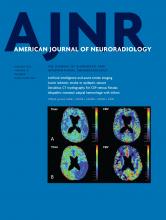Research ArticleNeurointervention
Intentional Stent Stenosis to Prevent Hyperperfusion Syndrome after Carotid Artery Stenting for Extremely High-Grade Stenosis
T. Mori, K. Yoshioka, Y. Tanno and S. Kasakura
American Journal of Neuroradiology January 2021, 42 (1) 132-137; DOI: https://doi.org/10.3174/ajnr.A6853
T. Mori
aFrom the Department of Stroke Treatment, Shonan Kamakura General Hospital, Kamakura, Japan.
K. Yoshioka
aFrom the Department of Stroke Treatment, Shonan Kamakura General Hospital, Kamakura, Japan.
Y. Tanno
aFrom the Department of Stroke Treatment, Shonan Kamakura General Hospital, Kamakura, Japan.
S. Kasakura
aFrom the Department of Stroke Treatment, Shonan Kamakura General Hospital, Kamakura, Japan.

References
- 1.↵
- Mori T,
- Fukuoka M,
- Kazita K, et al
- 2.
- Abou-Chebl A,
- Yadav JS,
- Reginelli JP, et al
- 3.↵
- Sundt TM Jr.,
- Sharbrough FW,
- Piepgras DG, et al
- 4.↵
- Piepgras DG,
- Morgan MK,
- Sundt TM Jr., et al
- 5.↵
- Nomura JI,
- Uwano I,
- Sasaki M, et al
- 6.↵
- Hayakawa M,
- Matsumaru Y,
- Sakai N, et al
- 7.↵
- 8.↵
- Kuroda H,
- Ogasawara K,
- Hirooka R, et al
- 9.↵
- Ogasawara K,
- Sakai N,
- Kuroiwa T, et al
- 10.↵
- Niimi J,
- Tasaka K,
- Nemoto F, et al
- 11.↵
- 12.↵
- 13.↵
- 14.↵
- Barnett HJ,
- Taylor DW,
- Eliasziw M, et al
- 15.↵
- 16.↵
- Iwata T,
- Mori T,
- Tajiri H, et al
- 17.↵
- 18.↵
- Iwata T,
- Mori T,
- Tanno Y, et al
- 19.↵
- Iwata T,
- Mori T,
- Miyazaki Y, et al
- 20.↵
- Yoshimura S,
- Yamada K,
- Kawasaki M, et al
- 21.↵
- Bussière M,
- Pelz DM,
- Kalapos P, et al
- 22.↵
- Kimura T,
- Yokoi H,
- Nakagawa Y, et al
- 23.↵
- Mori T,
- Kazita K,
- Chokyu K, et al
- 24.↵
- Kaku Y,
- Yoshimura S,
- Kokuzawa J
- 25.↵
- 26.↵
- Miyazaki Y,
- Mori T,
- Iwata T, et al
- 27.↵
- Nakazaki M,
- Mori T,
- Iwata T, et al
- 28.↵
- 29.↵
- Ogata A,
- Sonobe M,
- Kato N, et al
- 30.↵
- Baldi S,
- Zander T,
- Rabellino M, et al
In this issue
American Journal of Neuroradiology
Vol. 42, Issue 1
1 Jan 2021
Advertisement
T. Mori, K. Yoshioka, Y. Tanno, S. Kasakura
Intentional Stent Stenosis to Prevent Hyperperfusion Syndrome after Carotid Artery Stenting for Extremely High-Grade Stenosis
American Journal of Neuroradiology Jan 2021, 42 (1) 132-137; DOI: 10.3174/ajnr.A6853
0 Responses
Jump to section
Related Articles
Cited By...
This article has been cited by the following articles in journals that are participating in Crossref Cited-by Linking.
- Takahisa Mori, Kazuhiro Yoshioka, Yuhei Tanno, Shigen Kasakura, Yuichi MiyazakiEuropean Radiology 2022 32 3
- Takahisa Mori, Kazuhiro Yoshioka, Yuhei Tanno, Shigen KasakuraLife 2022 12 1
- Matija Zupan, Matej Perovnik, Janja Pretnar Oblak, Senta FrolLife 2024 14 11
- Kaijiang Kang, Peipei Gong, Feng Gao, Dapeng Mo, Xingquan Zhao, Zhongrong Miao, Ning MaAmerican Journal of Neuroradiology 2024 45 11
More in this TOC Section
Similar Articles
Advertisement











